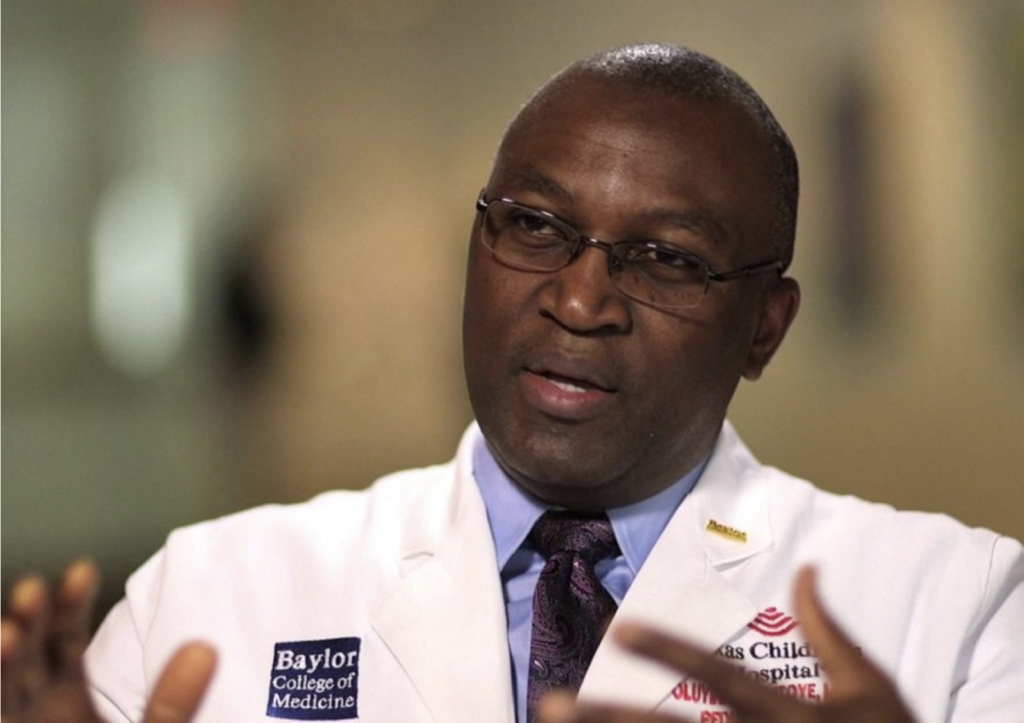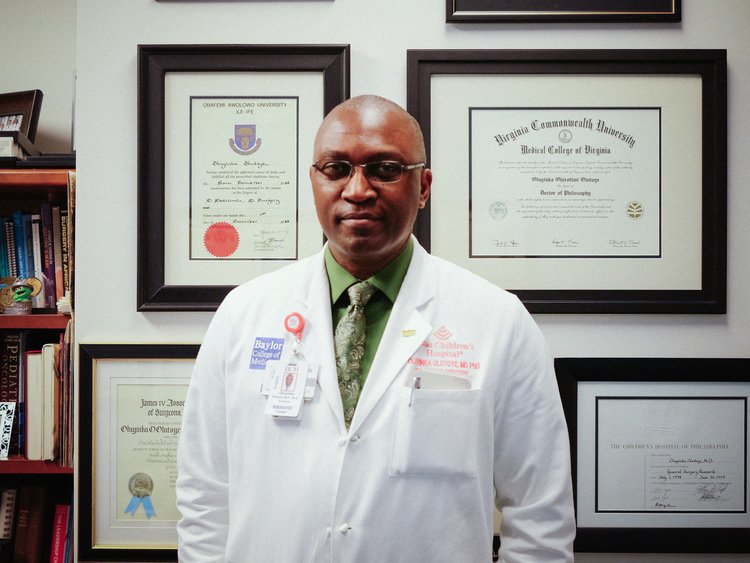
To put it simply, childbirth is a miracle in itself. It's so common nowadays that we rarely look at how complex it is for a woman to carry a baby for nine months to see another real-life living being born.
We think this happens only one time in a person's life, but one doctor was able to do this twice for one incredibly strong baby.
To carry out the operation on the baby named Lynlee Hope at 23 weeks, Oluyinka Olutoye, M.D., Ph.D. and his team removed the little one from her mother’s womb, operated on her and then returned her to the womb where the injuries from her operation healed and she continued to grow until she was born again at 36 weeks.
How it all happened is astounding too.
Margaret Boemer went for a routine ultrasound 16 weeks into her pregnancy with her third child. She quickly found out that things were far from routine.
"They saw something on the scan, and the doctor came in and told us that there was something seriously wrong with our baby and that she had a sacrococcygeal teratoma," the Texas mom reported to CNN. "And it was very shocking and scary, because we didn't know what that long word meant or what diagnosis that would bring."
Sacrococcygeal teratoma is a tumor that develops before birth and grows from a baby's coccyx, the tailbone. Found more often in girls than boys, this tumor occurs in one out of every 35,000 births.

Unfortunately, this was not the first bad news of Boemer's pregnancy. Originally, she had been pregnant with twins, but lost one of the babies before her second trimester.
It was a shock at 16 weeks to learn of her daughter's rare birth defect. The tumor is trying to grow by sucking blood flow from the baby, yet the baby is also trying to grow, too so it becomes like a "competition." And in some instances, the tumor wins and the heart just can't keep up and the heart goes into failure and the baby dies.
With a large tumor stealing the blood supply, Boemer's fetus was becoming more ill each day, doctors explained to the expectant mother. Something had to be done.
According to reports, a number of other doctors in hospitals in Texas “strongly recommended” that she should terminate the pregnancy and that any surgery on the baby would be "too risky."
That is until she met with Dr. Oluyinka Olutoye, his surgery partner Dr. Cass and their team who told her about another possibility: fetal surgery. This option, though, would not be an easy road. Even worse, her baby's chances of survival would be slim.
"LynLee didn't have much of a chance," Boemer said. "At 23 weeks, the tumor was shutting her heart down and causing her to go into cardiac failure, so it was a choice of allowing the tumor to take over her body or giving her a chance at life.
"It was an easy decision for us: We wanted to give her life."

She was 23 weeks and 5 days pregnant, when the emergency fetal surgery was performed. By this time, the tumor was nearly larger than the fetus!
The operation lasted for nearly five hours, but the doctors were working against time because most of the time is spent opening the uterus, and they didn't want the mom's health to be jeopardized. They worked carefully, both making the incision and sewing it up in order to make that uterus be as sealed and as water tight as possible.
Still, Cass said, the tumor, in this case, was so large a "huge" incision was needed to get to it, so it ended up that the baby was "hanging out in the air... Essentially, the fetus is outside, like completely out, all the amniotic fluid falls out, it's actually fairly dramatic," said Cass.
During the surgery, LynLee's heart slowed down to an incredibly low rate. "It basically stopped," said Cass. He credits the heart specialist, a key member of the team, for giving the right medication and transfusing the right amount of fluid, allowing the surgeons to continue their work.
The surgical team removed the bulk of the tumor. When they finished their operation, the surgeons placed LynLee back inside the womb and sewed her mother's uterus shut.
Boemer was on bed rest for the remainder of her pregnancy. There's a risk the fetus could be born immediately after the in utero surgery, or die. But in spite of her pain, she soldiered on and made it another 12 weeks to nearly 36 weeks -- full term -- when Lynlee Hope was born for the second time via C-section on June 6.
The little fighter, named for both her grandmothers, weighed 5 pounds and 5 ounces.
Immediately, the hospital staff whisked the newborn away to the neonatal intensive care unit for an evaluation, but...
... after this initial checkup, she was deemed healthy and transferred to the nursery.
After she was born, LynLee faced one more ordeal: removing the bits of tumor that surgeons could not reach, which had begun to grow again.
"At eight days old, she had more surgery, and they were able to remove the rest of the tumor," explained Boemer.
LynLee recovered in the NICU and weeks later, arrived in her family home.
Dr. Olutoye recalls that his desire to be a doctor, specifically in pediatrics, stemmed from a childhood experience in his native Nigeria.
“I had a sick family member, and a doctor made a house call to see them,” Olutoye said. “I remember following him around our home, trying to see as much as I could. After he left, I would play doctor around the house.”
After high school, Olutoye enrolled in a six-year medical program at Obafemi Awolowo University, Ile-Ife, Nigeria, where he graduated in 1988 as valedictorian with a Bachelor of Medicine and Bachelor of Surgery.
“I chose surgery because I liked being able to identify problems in the body and fix them,” Olutoye said. “When I was in school, I also enjoyed embryology, so pediatric surgery was a natural draw.”
Olutoye knew that if he stayed in Nigeria, he would not have access to the latest medical technology, so he moved to the U.S., but found his foreign degree a barrier to working as a surgeon. Refusing to give up, he accepted a pediatric internship at Howard University Hospital. He remained focused on his goal to become a pediatric surgeon, and he said the team at Howard supported his ambition, even helping him apply for the National Resident Matching Program the following year, which landed him an interview at Virginia Commonwealth University’s School of Medicine.
Andrew Wechsler, M.D., head of the Department of Surgery at the time, offered Olutoye a residency, but it was the opportunity to conduct his own research and work on a Ph.D. during his residency that cemented Olutoye’s decision to come to VCU.
“Dr. Wechsler really took a chance on me, especially being a foreign medical graduate,” he said. “I am always eternally grateful for that.”
He made the most of his opportunities. Under the guidance of Arnold Salzberg, M.D., then-chief of the Division of Pediatric Surgery, Olutoye completed his Ph.D. and his general surgery residency at VCU and landed a two-year fellowship in pediatric surgery at the Children’s Hospital of Philadelphia.
Now, Dr. Olutoye is Co-Director of the Texas Children's Fetal Center and fetal surgery team member, as well as a general pediatric surgeon. He uses his specialized clinical expertise in fetal and neonatal surgery, with a specific interest in congenital diaphragmatic hernia and complex wounds.
He has won several awards including the 2012 Denton A. Cooley Surgical Innovator Award at the Texas Children’s Hospital, Academy of Distinguished Educators Award at the Baylor College of Medicine, Molecular Surgeon Research Achievement Award at the Michael E. DeBakey Department of Surgery and Mark A. Wallace 2014 Catalyst Leader of the Year at the Texas Children’s Hospital.









